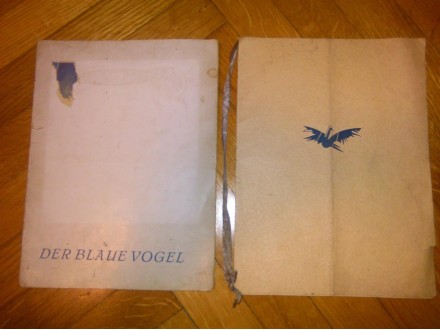Der Blaue Vogel-Plava ptica-Kabare-1925-AVANGARDA
| Cena: |
| Stanje: | Polovan sa vidljivim znacima korišćenja |
| Garancija: | Ne |
| Isporuka: | Pošta Post Express Lično preuzimanje |
| Plaćanje: | Tekući račun (pre slanja) Lično |
| Grad: |
Beograd-Vračar, Beograd-Vračar |
Tematika: Ostalo
ISBN: Ostalo
Godina izdanja: 1900 - 1949.
Jezik: Nemački
Kulturno dobro: Predmet koji prodajem nije kulturno dobro ili ovlašćena institucija odbija pravo preče kupovine
Autor: Strani
Der Blaue Vogel
Program i pesmarica ruskog avangardnog kabarea `Der Blaue Vogel` (Plava ptica), koji je s velikim uspehom nastupao u Berlinu dvadesetih godina proslog veka, kao i sirom sveta.
Program je na 16 strana, iz 1925. godine. Nazalost, nedostaje slika s prednje korice. Pesmarica je iz 1929. godine, jos ima originalnu traku, osam strana plus korice. VIDI SLIKE!
There is a lot to be said about Russians in Berlin. In the 1920s they were probably the largest immigrant group. Most of them were refugees from the Bolshevik revolution and its subsequent civil war and terror. Some came to be very well known, like the writer Vladimir Nabokov. So many were Berlin Russians that Charlottenburg district got to be popularly known as Charlottengrad…
There were also artists like Vassily Kandinsky and Marc Chagall. And Pavel Tchelitchew, less known than the other but whose works have an unmistakable touch of the 1920s. His are the set designs shown in this post, done for a Russian-German cabaret called Der Blaue Vogel (The Blue Bird) That name should not be confused with another animal of the same colour and times, The Blue Rider... Nor with The Blue Mouse, another Berlin cabaret founded by the Danish Argus Bang, but that is a completely different and not wholly veracious story...). It was a literary and folkloristic cabaret composed of Russian emigrants, founded in 1921 in Berlin, by J. Duvan-Torzoff.
The style of the show was strongly influenced by the Letuchaya Mysh (The Bat, the first Russian cabaret, created by Nikita Baliev in 1908 at the Moscow Art Theater, known as Stanislavsky and Anton Chekhov own scene) and characterized by a stylized representation in all the elements: sets, costumes, sounds and music, movements of the actors. This was combined with the choice of using a mixture of several languages: Russian, French, English and German.
The contents concerned mainly literary parodies, such as those of Maurice Maeterlinck`s works (L`Oiseau bleu was one of his plays, which had its premier in 1908 at the Moscow Art Theater), but also folkloristic staging in Russian style, with elements of social criticism.
The Blaue Vogel knew significant popularity under the direction of J.D. Jushnij, who also performed as conférencier, taking the company on tour all over the world. The project ended in 1931, after over 3000 performances. In 1945, in Munich, some Russian artists tried to revive the Blaue Vogel, but with little success.
Из воспоминаний Романа Гуля: `Постоянным русским театром в Берлине была “Синяя птица” — директор Яков Южный. Этот театр по своему стилю и репертуару был схож с знаменитой “Летучей мышью” Никиты Балиева, ставшей эмигранткой, улетевшей из советской Москвы в Париж, где Балиев с огромным успехом вел свой театр. В “Синей птице” ведущие актрисы были Валентина Аренцвари, Е.Девильер и Юлия Бекефи, “потрясавшая” зрителей в “Рязанской пляске”. В труппе были: режиссер И.Дуван-Торцов, сам Я.Южный, знаменитый эстрадник Виктор Хенкин, музыкальной частью ведал М.M.Шопелло-Давыдов, художественное оформление — три талантливых молодых художника: А.Худяков, Г.Пожедаев и П.Челищев, сделавший позже международную карьеру.` Репертуар “Синей птицы” включал множество милых и остроумных музыкальных безделок — “Стрелочек”, “Полночная полька”, “Русский танец”, “Вечерний звон”, “Бурлаки”, “Повариха и трубочист”, “Рязанская пляска”, “Крестьянские песни”, “Лубки”, “Как хороши, как свежи были розы”, “Песенки кинто” — коронный номер Виктора Хенкина
tags: avangarda, ruska emigracija, ruski emigranti, berlin, vajmarska republika, dvadesete, suprematizam, konstruktivizam, sagal, maljevic, zenit, zenitizam...
Predmet: 73684129













